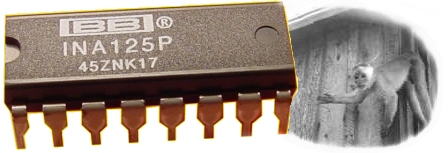
|
Static Tests
Performed on the electronic test stands July 2004 through August 2005 |

|
Static Tests
Performed on the electronic test stands July 2004 through August 2005 |
| Go to Fall 2005 tests > |
| Excel File |
Thrust Curve |
Description |
Video |
||||||||||||||||||
| 7-11-04C Excel Spreadsheet |

|
54mm Loki motor, 3 grains plain rcandy,
500lb test stand. Spreadsheet data captured and contributed
by Richard Creamer, compares well with XY plotter
graph generated by Steve |
Video 1.3 meg |
||||||||||||||||||
| 7-11-04D |

|
54mm Loki motor, 3 grains rcandy with
1% Fe2O3, 500lb test stand. Spreadsheet data captured and contributed
by Richard Creamer, compares closely with XY
plotter graph generated by Steve (same graph as above, four tests
on same page.) |
Video 1.4 meg |
||||||||||||||||||
| 7-11-04e No spreadsheet |

|
54mm Loki motor 3 grains rcandy, 2 of
them containing 4.6 percent fine Ti flakes. Recorded on XY
plotter graph only, no spreadsheet this time. Nice video
of Ti firing in the rain. |
Video 1.3 meg |
||||||||||||||||||
| 7-18-04A |
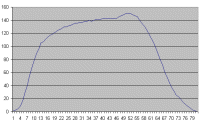
|
Dataq unit finally arrived, now I can
test at home. 54mm Loki motor, 3 grains plain rcandy, old grains
that had been scraped down to solid propellant. Worked OK, nice
"elephant" curve. |
Video 1.5 meg |
||||||||||||||||||
| 7-19-04B |
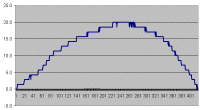
|
38mm 2-grain Dr. Rocket casing, 2 old
Bates grains plain rcandy. Fired in 500 lb test stand, odd "step
pyramid" graph. Note horses in background bugging out. |
Video 1.5 meg |
||||||||||||||||||
| 7-21-04a |
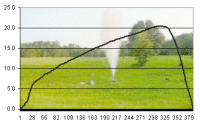
|
38mm 2-grain casing, two old grains stuck
together and burned as one. Fired in 500 lb test stand. Good
progressive thrust curve |
Video 1.2 meg |
||||||||||||||||||
| 7-21-04b |
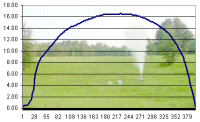
|
38mm 2-grain casing, two old grains,
separated this time. Fired in 500 lb test stand, good progressive-regressive
thrust curve |
|||||||||||||||||||
| 7-24-04a |
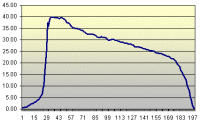
|
38/240 casing burning 1 uninhibited grain
plain rcandy. Fired in 44lb test stand, good regressive thrust
curve |
|||||||||||||||||||
| 7-24-04b |
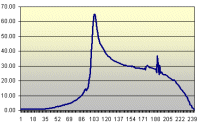
|
38/240 casing burning 1 uninhibited grain
plain rcandy. Fired in 44lb test stand, regressive thrust curve
with slow build-up and large spikes |
|||||||||||||||||||
| 7-28-04a |
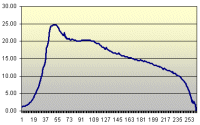
|
38/240 casing burning 1 uninhibited grain
plain rcandy. Fired in 44lb test stand. Wooden plug used instead
of paper to eliminate spikes. Very slow build-up, followed by
good regressive thrust curve. |
|||||||||||||||||||
| 7-28-04b |
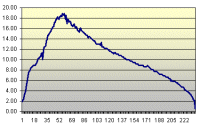
|
38/240 casing burning 1 uninhibited grain
plain rcandy. Fired in 44lb test stand, regressive thrust curve.
Wooden plug used instead of paper to eliminate spikes. Very
slow build-up, followed by good regressive thrust curve. |
|||||||||||||||||||
| 7-29-04a |
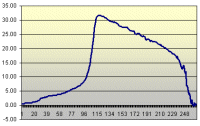
|
38/240 casing burning 1 uninhibited grain
rcandy with 1% Fe2O3 to speed ignition. Fired in 44lb test stand,
slow ramp-up to pressure but not as bad as the previous 2. Good
regressive thrust curve thereafter. |
|||||||||||||||||||
| 7-29-04c |

|
29mm 2-grain Loki case, first firing.
Single uninhibited grain, rcandy with Fe2O3. Fired in
44lb test stand, nice regressive curve. |
|||||||||||||||||||
| 8-1-04a |
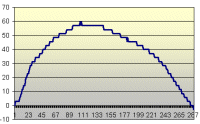
|
38mm 4-grain plain old rcandy, in storage
since 11/03 |
|||||||||||||||||||
| 8-2-04b |
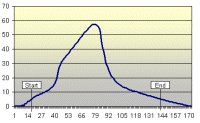
|
29mm Loki motor, single outside-inhibited
grain, progressive burn |
|||||||||||||||||||
| 8-2-04e |
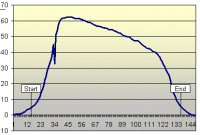
|
38mm Dr. Rocket, single uninhibited grain,
1% Fe2O3 |
|||||||||||||||||||
| 8-2-04f |
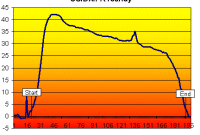
|
38mm Dr. Rocket, single uninhibited grain,
experimental propellant made with sucrose, dextrose and fructose. |
|||||||||||||||||||
| 8-4-04a |
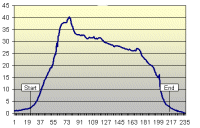
|
38mm Dr. Rocket, single uninhibited grain,
Sugar Syrup propellant made in October 2003. The propellant
works. but I wonder why the graph looks so rough... |
|||||||||||||||||||
| 8-8-04d |
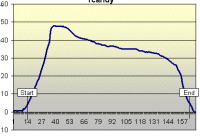
|
38mm Dr. Rocket, single uninhibited grain,
sucrose/dextrose/fructose rcandy test |
Video 1.2 meg |
||||||||||||||||||
| 8-8-04e |
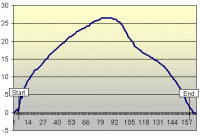
|
29mm Loki motor, sucrose/dextrose/fructose
(SDF) rcandy in 2 inhibited grains. |
Video 1.3 meg |
||||||||||||||||||
| 8-9-04d |
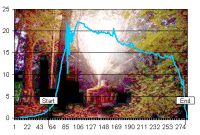
|
38mm Dr. Rocket motor single uninhibited
grain, slow SDF with 10% Ti |
Video 1.3 meg |
||||||||||||||||||
| 8-10-04b |
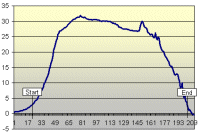
|
38mm uninhibited single grain, slow SDF
with 1% ultramarine, ignitor may have hung up causing spike |
Video 1.8 meg |
||||||||||||||||||
| 8-10-04c |
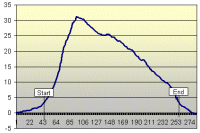
|
38mm uninhibited single grain, slow SDF
with 1% ultramarine. Replication of 8-10-04b but with more care
given to ignitor |
Video 1.3 meg |
||||||||||||||||||
| 8-17-04a |
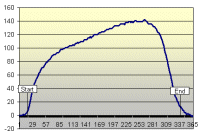
|
54mm Bates grains with Ti and slow-burning
smoke grain. |
Video 6 megs |
||||||||||||||||||
| 8-22-04c |
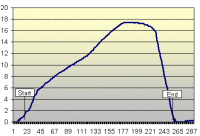
|
29mm Loki motor, 2 Bates grains, glycerin
rcandy. Works well, despite propellant being somewhat soft and
flexible. I am guessing that the grains stuck together and burned
as one to generate this strongly-progressive thrust curve. Note
the similarity to the next test on 11/22/04. |
Video 1 meg |
||||||||||||||||||
| 11-22-04a |
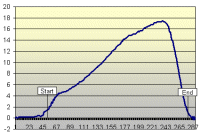
|
29mm Loki motor, single inhibited grain,
mixed rcandy. Fired primarily to test new load cell amp, which works
just fine. |
Video 1.3 meg |
||||||||||||||||||
| 11-26-04a |
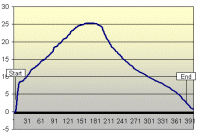
|
38mm Dr. Rocket casing, single moon-burner
grain. Funny thrust curve, strongly progressive/regressive. |
Video 1.1 meg |
||||||||||||||||||
| 12-5-04A |
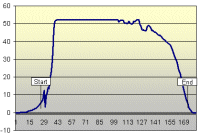
|
First fully successful test of
motor-eject delay grain. 38-240 casing, single uninhibited
grain. Using high-gain setting for load cell amplifier, exceeded
either the load cell or the Dataq unit limits and truncated the data.
Really don't think I got that flat a burn profile. Another technical triumph: the video started late, so that the ejection was not filmed. It fired perhaps one second after the video ended, estimated 11 second delay. |
Video 3.8 meg |
||||||||||||||||||
| 12-6-04A |
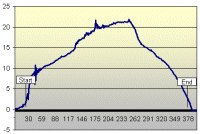
|
38-240 casing, single grain inhibited
with 5 layers of aluminum-foil tape. Progressive burn, as expected,
with a few funny spikes, possibly related to the quick-and-easy inhibitor.
Delay grain worked, ejection occurred 8.25 seconds after ignitor
fired. |
Video 5.3 meg |
||||||||||||||||||
| 12-11-04C |
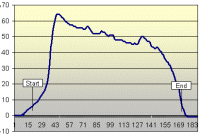
|
38-240 Dr. Rocket casing with single
uninhibited grain. Delay grain header fires ejection charge
4.96 seconds after ignitor fires, but ignition lag eliminated 1 second
or so. |
Video 1.7 meg |
||||||||||||||||||
| 12-12-04C |
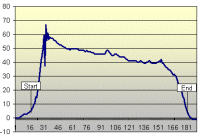
|
38-240 casing, single uninhibited
grain. Delay grain header works well, provides 6.4 seconds delay
time. |
Video 2.1 meg |
||||||||||||||||||
| 12-12-04D |
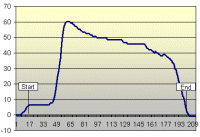
|
38-240 casing, single uninhibited grain
rcandy with 1% MgSO4 to try to retard burn rate. Duplex header
grain 0.913 inch long provided delay of 11.36 seconds from ignitor firing,
9.961 seconds from onset of full thrust. |
Video 3.2 meg |
||||||||||||||||||
| 12-19-04B |
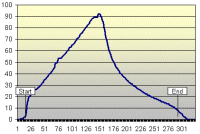
|
38-480 Dr. Rocket casing, 2 long, poorly-inhibited
grains, long header grain gave about 7 seconds delay, less than
expected. |
Video 2.1 meg |
||||||||||||||||||
| 12-20-04B |
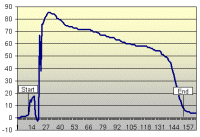
|
38-480 Dr. Rocket casing half-filled
with one uninhibited grain. Long header grain with two propellant
compositions gave 12.3 seconds delay |
Video 3.7 meg |
||||||||||||||||||
| 12-22-04B |
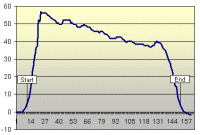
|
38-240 casing, single uninhibited grain
using caramel-color rcandy. Delay grain 0.97 inches long, using
chocolate-brown reprocessed rcandy with 0.6% Fe2O3, 17 seconds per
inch. Ejection occurs 11.28 seconds after ignitor fires, 9.24
seconds after full thrust begins |
Video 5.4 meg |
||||||||||||||||||
| 12-22-04C |
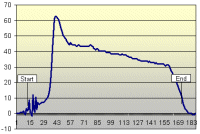
|
38-240 casing, single uninhibited grain
using chocolate-color rcandy, no continuous burn at 1atmosphere.
Delay grain 0.917 inches long, using chocolate-brown reprocessed
rcandy with 0.6% Fe2O3, 17 seconds per inch. Ejection occurs
about 15 seconds after full thrust began, exact time not known because
video ran out shortly before ejection occurred. |
Video 5.4 meg |
||||||||||||||||||
| 12-24-04B |
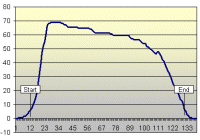
|
38-240 casing, single uninhibited grain
using sucrose/dextrose rcandy with 0.3% Fe2O3, burn rate 10 seconds/inch.
Delay grain is 7 second Fe2O3 rcandy, 0.979 inch long. Ejection
occurs 5.08 seconds after ignitor fires, 4.6 seconds after full thrust
begins |
Video 1.8 meg |
||||||||||||||||||
| 12-25-04A |
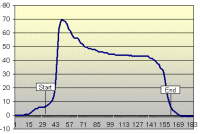
|
38-240 casing, single uninhibited grain
using sucrose/dextrose rcandy, burn rate 15 seconds/inch. Grain
dusted with Fe2O3 for quick ignition, but long pre-burn occurred anyway.
Spike at beginning of thrust curve is thought due to this coating
of catalyst. Delay grain is 10 second Fe2O3 rcandy, 1.55 inches
long. Ejection occurs 10.44 seconds after ignitor fires, 8.52
seconds after full thrust begins. |
Video 3 meg
|
||||||||||||||||||
| 12-27-04A |
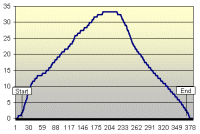
|
38-360 casing, 3 Bates grains,
slow rcandy, each grain dusted with red iron oxide. Big funny
hump of a thrust curve. Wimpy burn, low ISP. Delay charge
fired too quickly, only 0.64 seconds after thrust ended, about 3 seconds
after ignitor popped, still rather quick, considering charge is 1.33
inches long and burns at 10 ips at 1 atm (IPS = inches per second. Remember
reel-to-reel tape?) Air bubble in delay composition is thought
to be the problem |
Video 1.3 meg |
||||||||||||||||||
| 12-27-04B |
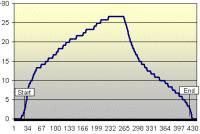
|
38-360 casing, 3 Bates grains,
slow rcandy. Nearly identical to 12-27-04A except grains not
dusted with RIO, instead, 2 inches of black match placed between grains.
Big hump thrust curve again, and another wimpy burn, even lower
ISP than the last. Predicted delay: 5.5 seconds. Actual
delay: 3.8 seconds. This not counting possibility that delay
grain started when ignitor fired. |
Video 1.5 meg |
||||||||||||||||||
| 12-30-04A |
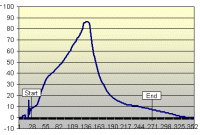
|
38-480 casing, single inhibited
grain, delay grain header made from short section of 1/2 inch cpvc
tubing glued to an adapted, 1/2x3/4 inch cpvc. This makes the
grain 2 inches long and 0.870 inch diameter at the beginning, tapering
to 1/2 inch diameter at the ejection end. Grain sealed OK, no blowby.
And it burned all the way through, but did not ignite ejection charge.
Thought is that BP separated from delay grain at some point,
perhaps during thrust. |
Video 10 meg! |
||||||||||||||||||
| 12-31-04A |
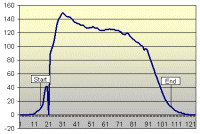
|
38-480 casing burning a single
uninhibited grain weighing 162 grams. Catalyzed with 1% RIO, it
also contains some coarse Ti. Very quick burn, 0.37 second.
Delay grain is dual-diameter, 2.034 inches long, composition
is the same propellant used in the grains, 7 seconds per inch at 1
atmosphere. Delay grain ignited ejection charge 12.6 seconds after
first thrust, 12.96 seconds after ignitor fired. Funny spike
at beginning of graph might be ignitor emerging, might be test setup
anomaly. Similar spike on next test. |
Video 0.4 meg |
||||||||||||||||||
| 12-31-04B |
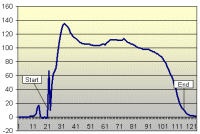
|
A near-replica of 12-31-04A, using
38-480 casing burning a single uninhibited grain weighing 163 grams.
Catalyzed with 1% RIO, it also contains some coarse Ti. Very
quick burn, 0.39 second. Delay grain is dual-diameter, 2.034 inches
long, composition is the same propellant used in the grains, 7 seconds
per inch at 1 atmosphere. Delay grain ignited ejection charge
13.8 seconds after first thrust, 14.039 seconds after ignitor fired |
Video 0.4 meg |
||||||||||||||||||
| 1-1-05A |
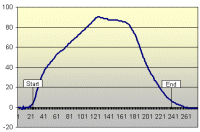
|
"Flight Motor" using 3 inhibited
grains in the 38-720 casing. Mildly catalyzed rcandy propellant
with a trace of coarse Ti. Nozzle-end grain had larger core,
which is thought to have caused the slight regression between the peak
and the drop, as it would have burned out first. Dual-diameter delay grain fired ejection charge 12.1 seconds after ignition. Prediction algorithm worked out for delay grains, in this case was about 1/3 second in error. |
Video 0.4 meg |
||||||||||||||||||
| 1-2-05B |
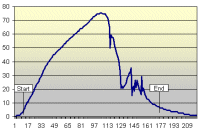
|
Two Bates grains in 38-360 casing.
Duplex header grain, 2 inches long gave delay of 10.3 seconds,
1.72 seconds sooner than predicted. Experimental use of flat steel "fender washer" in front of nozzle to create small, stable nozzle throat opening. Washer was super-glued to an Aerotech phenolic nozzle, but motor pressure held it in place during burn. Or did it? Funny spikes at end are due to what? |
Video 0.4 meg |
||||||||||||||||||
| 1-2-05C |
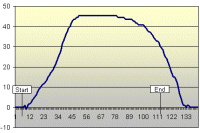
|
Single uninhibited grain in 38-240
casing. Again using steel washer for nozzle throat. End
broken off at about 45 degree angle. This was an error, I was
trying to make an inhibited grain and got too rough with the coring
rod. This propellant is much drier than usual, and thus more brittle.
Some water is good! Single-diameter delay grain about 1.5 inches long gave 14.4 seconds delay, 2.85 seconds longer than expected. That is an oddity - they are usually shorter than predicted. |
Video 5 megs |
||||||||||||||||||
| 1-2-05D |
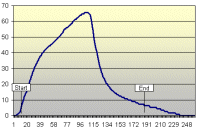
|
Two Bates grains in 38-360 casing.
Steel washer for nozzle throat. Single-diameter delay
grain about 1.5 inches long gave delay of 10.7 seconds, a little longer
than predicted, but this time by only about .7 second. |
Video 5 megs |
||||||||||||||||||
| 1-6-05A |
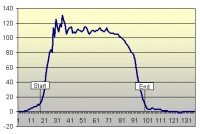
|
First test of the bathroom scale
turned test stand. Motor is a 38-240 sized uninhibited, catalyzed
grain, but burned in the 38-360 casing to make room for the long,
large delay grain. Graph is a bit rough, as you can see. Rhythmic
peaks look suspiciously like resonance, which would not be surprising
given the complex beam-and-lever arrangement in this stand. Peak
thrust and ISP are higher than ever measured with this type of motor,
making me suspicious about the accuracy of the scale. Then
again, look at the video and notice how much it drives the table down.
I had to lean on the table with most of my 179 lbs to get it to
flex that much. And high pressure increases ISP. |
Video 0.8 meg |
||||||||||||||||||
| 1-7-05B1 Load cell 1-7-05B2 Bath Scale |
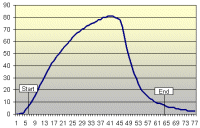
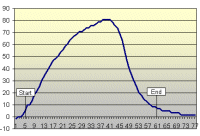
|
Dual-stand static test. Load
cell test stand A (44lb load cell) placed on the bathroom scale stand,
where it fits very nicely. Dataq unit set to record from both
devices, thus the same motor burn will generate two thrust curves. I
am pleased that the two curves are very similar, as it suggests the bathroom
scale may produce reasonably accurate output. Excel file 1-7-05B1 uses data from the load cell stand, file 1-7-05B2 is from the bathroom scale test stand.
|
Video 1.1 meg |
||||||||||||||||||
| 1-9-05B1 Load cell 1-9-05B2 Bath Scale |
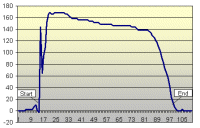
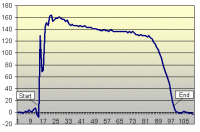
|
Similar to 1-7-05B but using the
500 lb test stand and a 54mm casing firing a moderate-sized uninhibited
grain. This grain should deliver roughly the same level of thrust
as a full load of Bates grains, just for a shorter time.
Since the load cell test stand is sitting on top of the bath scale when motor is fired, the bath scale is reading "second hand" thrust. The mass, flex, and springiness of the scale may have modified the transfer of thrust somewhat. |
Video 1.2 meg |
||||||||||||||||||
| 1-11-05A |
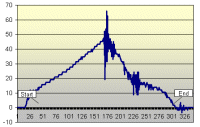
|
38-360 casing fired on bath scale,
this time the motor holder is fastened with screws to the platform,
attempting to isolate some of the anomalies. It might have
done so, but the delay grain failed about halfway through the burn,
allowing propellant gasses to flow forward. The scale will be
OK once I scrape the char off and give it a coat of paint. The
little hole in the Dr. Rocket delay grain bulkhead is now a big ragged
hole. I need another one. This delay grain is one that had an air gap at one end, which I filled with epoxy. Another one like this was used in test 12/27/04A, which fired very early. So filling gaps with epoxy might be a bad idea. |
Video 1.5 meg |
||||||||||||||||||
| 1-12-05A |
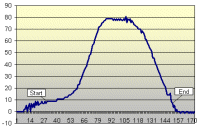
|
38-240 casing burning one uninhibited
grain. Slow start was expected as this is a slow-burning batch
of propellant and there were no ignition accelerators. Using
bath scale test stand, rehabilitated a bit from yesterday's little incident.
I removed the scorched plastic, cardboard and glue from the weighing
platform, and reattached the motor stand to it with screws. This
thrust curve seems fairly smooth, with a few jitters here and there. Data
is just about what was expected, suggesting this cheap stand may yet
prove to be fairly accurate. |
Video 1.2 meg |
||||||||||||||||||
| 1-17-05A |
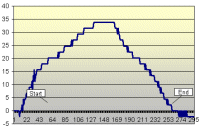
|
A rectangle of hardwood plywood,
3/4 inch thick, attached to the top of the scale platform with screws.
Motor mount attached to that with more screws. Odd step-pyramid
graph suggests that gain on the amp is is too low, but I haven't changed
it. Thrust lower than expected, ISP lower than expected, but this
was not a wimpy burn. Something is wrong here... OK, I found it. One of the short levers inside the flab-o-matic was unhooked from its hanger, so that it no longer transferred its portion of the weight to the V-bracket that hangs on the load cell. I will take more care in reassembling the scale from here on. |
Video 1.0 meg |
||||||||||||||||||
| 1-22-05A |
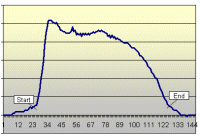
|
Single uninhibited grain in 38-240
casing, primed with a bit of Red Dot on the outside of the grain
and on the head end. Tested on bath scale, which is assembled more carefully this time. Curve is a bit jagged and has that funny dip with point, but in all it looks pretty good. ISP of 125 is a bit on the high side, but within the realm of possibility. Especially since I am using steel nozzle "inserts" allowing me to run at higher ISP than previously. |
Video 1.0 meg |
||||||||||||||||||
| 1-23-05B1 Bath Scale 1-23-05B2 Load Cell |
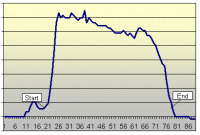
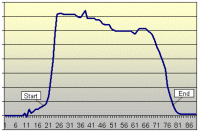
|
Time for another dual static test.
I have gotten a couple of suspiciously-optimistic curves from
the bath scale test stand, including yesterday's (1-22-05A) and the
first done on the bathroom scale (1-6-05A). Both were possible,
but on the high side of my average. This time Test Stand A with the 20kg load cell from Aerocon is bolted to the top of the flab-o-matic bathroom scale. Gain on the 20kb cell amp is set at 607 ohms, resulting in moderately low gain. That might explain some of the "flats" in the load cell curve. Again, flab-o-matic is a bit "jittery", but except for a few little bumps here and there the curves resemble each other. A few odd features that look like electronic glitches, but some are reproduced by both stands thus are likely to be real. Given the flats in the load cell curve, I am beginning to wonder if the bathroom scale data is more reflective of what is going on with the the motor. The load cell may not be picking up subtle variations because I have its gain set too low. In this test, the bath scale reads a little lower (123Ns) than the load cell (125Ns). This suggests that the high-ish readings on previous tests with the bathroom scale may have been for real. |
Video 0.8 meg |
||||||||||||||||||
| 2-6-05A |
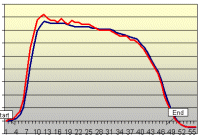
|
Piggybacked 500lbf load cell test
stand with bath scale stand, attached firmly with wood screws. Load
cell amp set at high gain (47ohm) and 5vdc excitation. Tested with 38/240 casing firing a single uninhibited grain RIO catalyzed rcandy. Bath scale seems slightly more responsive, gives somewhat higher thrust readings at beginning, slightly lower at end but averaging out very nearly the same overall thrust and ISP. |
Video 1.2 meg |
||||||||||||||||||
| 2-10-05B 2-10-05C |
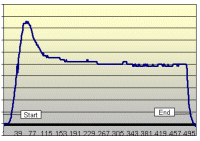
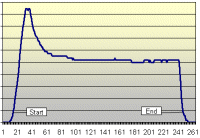
|
Two Estes C6-5 motors tested on
20kg load cell test stand, primarily to see if INA125 amplifier C could
enable this load cell to respond well to such light loads. Apparently
it can. Load cell excitation was set to 10 volts. Resistance for gain input set by turning on all of the resistors, offering a total resistance of 30 ohms, since they are in parallel. Head-end clay was scraped out and ejection charge removed from casing before firing. Loaded casing (minus ejection charge and clay) weighed 23.9g, fired motor weight is 11.1g, so propellant charge must weight 12.8g. So I should now be able to test my own model rocket motors and see how they compare. Delivered ISP for these comes out 74 or 75, so rcandy has the potential to do a little better. Oh. I forgot about the delay charge. I will guess that to be 3g until I figure out how to weight it. |
No Video |
||||||||||||||||||
| 2-12-05C4 |
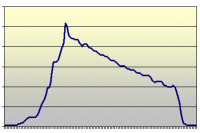
|
My own "model rocket" motor, made
according to my instructions.
18mm diameter motor casing, inside diameter 1/2 inch. Uninhibited
grain, weighing 5.6 grams. Burn time 0.40 second.Total thrust
2.63 Ns, placing it squarely in the "B" range. ISP of 47.9 is
an insult. I am led to wonder if the test stand is working right, but the Estes motors came out just about like the specs indicated. More likely cause: this motor did not ignite well. It burned slowly for a second or two before making it's whuff of thrust, so I think much of its propellant was wasted. |
No Video |
||||||||||||||||||
| 2-13-05A |
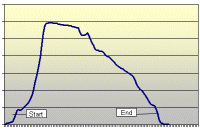
|
Replication of 2-12-05C4 but using
6.7grams of propellant, and adding a pinch of black powder to the
casing to help get ignition going. Much better performance. Burn time 0.39 second.Total thrust of 6.36 Ns places it in the C range where it belongs. Nice rise to peak thrust, regressive profile, as expected from an uninhibited grain. ISP of 96.9 is good for this small of a motor, with its low Kn ratio. |
No Video |
||||||||||||||||||
| 2-19-05B |
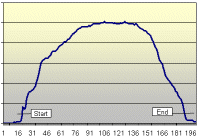
|
Similar to 2-13-05A but using two
tiny Bates grains in a reloaded Estes motor casing. Nozzle throat
of 0.129 inch. Longer burn of 0.7 second, total thrust of 5.87
Ns places it at the low end of the C spectrum. ISP of 92.2
is slightly less than the 2/13 test, possibly because of lower Kn ratio. I am rather proud of this nice humpy curve. It even looks sorta like the theoretical curve. Video is thoroughly underwhelming, so I am not wasting webspace on it unless requested. |
No Video |
||||||||||||||||||
| 3-1-05C |
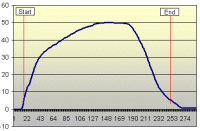
|
38-360 casing firing three Bates
grains of dark, slow toaster-oven rcandy with1 percent fine Ti flakes.
Also placed a layer of fuse paper between each grain and at
the ends to improve ignition. First ignitor failed - it used
black powder only. Second one worked, using BP and a little Mg.
Burn is somewhat progressive, but should have been slightly regressive. Difference is thought due to slow ignition between grains, so fuse paper is apparently not the magic answer. Tested in Stand A (20kg) using INA 125 amp C set at 10v excitation and 220 ohms gain resistance. |
Video 1 meg |
||||||||||||||||||
| 3-3-05C |
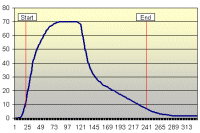
|
38-360 casing, three Bates grains,
including 2.5 percent Ti "sponge" 40-80 mesh. I was hoping
this to be a very fine powder so that it would burn in the casing
and enhance ISP. Instead we get really nice sparkles, and a
lot of them! Square inch of "black match paper" inserted between
the grains and at the head end to facilitate ignition - not sure
if it worked, but ignition was pretty quick. Long tail-off is
thought due to off-center core - this one was cored by hand. ISP
is 129 or 125, depending upon which load-cell calibration you choose
to believe. |
Video 1 meg |
||||||||||||||||||
| 3-4-05B |
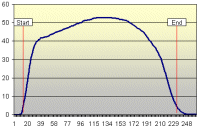
|
Repeat of yesterday's test, including
only 1 percent Ti sponge. Much prettier thrust curve is attributed
to better-centered grains, and possibly to the black match paper
inserted between the grains and at the ends. While they did
not seem to speed up ignition very much, they may have made for more
uniform ignition. This could be seen in the quick ramp-up of yesterday's
test too. This load made as a demo for the packaging page. |
Video 1 meg |
||||||||||||||||||
| 3-5-05A |
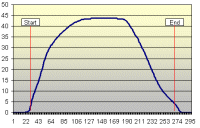
|
Very similar to 3/4/05B and 3/3/05C
except burning some of the slowest candy propellant I have made. Chocolate
brown, and not in the least continuous burning at one atmosphere.
Good burn in motor casing, though. Tail-off slope might
be due to inhibitor tube in which the grains were molded - it wasn't
perfectly round. |
Video Coming Soon! |
||||||||||||||||||
| 3-6-05B |
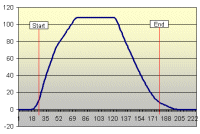
|
Similar to last two tests but using
the 38-480 motor casing with 4 grains. Load cell amplifier set
at 10v excitation, 220 ohm gain, and it is too high. Top of
curve appears clipped. Subsequent test of load cell system verified
that it topped out at 108 lbf. I did not expect this motor to generate
quite that much thrust nor to burn quite as fast. Prime suspect:
chunky propellant. Anyway, it had a good, quick ramp-up like
the last few tests using black match paper between the grains, so this
is a technique I might keep. Funny little "chuff" at the end of video
is occasionally seen in motors with very slow-burning propellant. |
Video 1.3 meg |
||||||||||||||||||
| 3-13-05A |
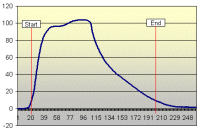
|
This one is as much a test of the
setup as the motor. Using three 100-foot electrical drop cords
to run data signal from load cell amp 'way out in the field to the
Dataq unit at my desktop. Long cord seems to work OK. 20kg
load cell, INA125 amp C set to 10v excitation, 470 ohm gain to prevent
truncation such as occurred in 3/6/05 test. Motor is 38-480,
not quite fully loaded - this load was intended for launch with long
delay grain, so head-end grain is only about 3/4ths inch long. Black
match paper inserted between grains. Quick rise to pressure, but
long tail-off. Why? Don't know. Perhaps the inhibitor
tube was not quite round. |
Video 1 meg |
||||||||||||||||||
| 3-17-05A |
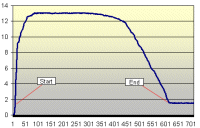
|
Moon burner grain tested in 38-360 casing. Core is offset entirely to inhibitor wall. Very flat burn may be due to a "sticky" motor holder, not necessarily the motor. Short piece of black match at head end may have contributed to quick presure rise. Low ISP of 89 and extra-long burn of 2.5 seconds are probably due to low Kn of 132 (or perhaps sticky motor holder - gotta fix that!) Exhaust jet seems to be angled to the left at the beginning of burn, straightens out as burn progresses. I imagine this is due to the off-center core. I wonder how much this might influence the direction of a flight. | Video1 1.4 meg distant Video2 1.4 meg closeup |
||||||||||||||||||
| 3-20-05A |
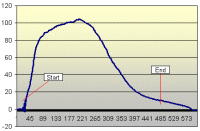
|
Moon-burner grain in Loki 54mm motor.
Secondary experiment is to introduce Ti sparks to the exhaust plume
well after the burn is underway. Ti propellant glued to one side
of inhibitor tube, coring rod inserted on other side and hot propellant
packed in between. But Ti sparks were seen from the beginning of thrust. This, the somewhat progressive thrust curve, and the short burn time all suggest inhibitor failure. Not surprising, grain was klutzed together, no doubt had flaws. Video 1 is close up, video 2 from a distance. |
Video
1 2 meg Video 2 1.5 meg |
||||||||||||||||||
| 3-25-05A |
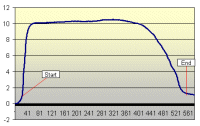
|
Last time, I underestimated the difficulties
in constructing the two-propellant Ti-delayed moon-burner grain and
ended up with one that didn't quite work. Today I did it with
a more modest grain size, and it worked quite well. 38/240 casing,
single moon-burner grain. Two seconds burn time, Ti entered the
fray .879 seconds into the burn. Low Kn, low efficiency, low thrust.
But a nice display! I will try it soon with higher Kn ratio.
Fuse paper ignitor Shelf at end of burn is probably due to motor being "stuck" in the holder tube, which is being deformed by repeated heatings. This stickiness also makes flatness of the curve questionable. |
Video 1 (closeup) 1.7 megs Video 2 (distant) 1.6 megs |
||||||||||||||||||
| 3-26-05A |
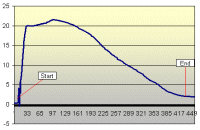
|
38-240 casing, single moonburner grain using
the "hot dog" approach to delay entry of Ti into the burn. Delay
was slight, perhaps due to the fact that I lost track of where the Ti propellant
was inside the grain, and may have put the core too close to it. Or
it could have been a bubble. Fuse paper ignitor. Propellant weight: 102g, Total thrust: 102 Ns, Burn time: 1.7 second, ISP: 102 |
Video 1.5 meg |
||||||||||||||||||
| 4-2-05B |
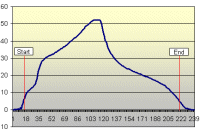
|
Mostly a demonstration, but gathered
data anyway. Single core-burning grain. Progressive burn
was expected, long trail-off was not. First ignitor failed. It was made with fuse paper. Second ignitor also failed. It was BP in masking tape with pinch of Ti. Third ignitor worked - I put a little BP & Ti in the case to give it a boost. Afterward I realized that the ignitors were being pushed down into the header recess on the Dr. Rocket motor, and thus were not in contact with the grain upon firing. |
Video 1 meg |
||||||||||||||||||
| 4-3-05A |
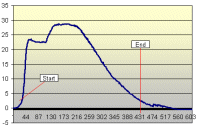
|
38-360 moon-burner with delayed Ti sub-grain.
Mold made from 1 inch PVC allowing me to make a crescent-shaped
insert of propellant with 10% Ti. This placed in grain "pre-form"
mold of 1 inch PVC, 7 inches long, and warm plain candy pressed around
it. Warmed again to soften, pressed into 38mm inhibitor tube that
had been epoxied. This made a much cleaner shape for the Ti slug.
Performed much as hoped, except for funny notch and hump in thrust
curve. Burn time 1.7 seconds, Ti entered the fray at .668 seconds.
Fuse paper ignitor |
Video 1.3 megs |
||||||||||||||||||
| 4-3-05B |
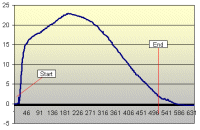
|
Mostly a replication of the previous
test, but adding a 10g strip of highly catalyzed propellant to the
backside of the 25g Ti crescent sub-grain. Thought is that as the
final sliver is burned, it being catalyzed will make it burn faster,
reducing the tail-off. Fuse paper ignitor Ti emerged from nozzle almost immediately, probably due to a flaw in the grain. I noticed a large bubble in the middle of the plain propellant which should have protected the Ti, but assumed the pressing would eliminate it. Apparently not. Fairly good performance otherwise. |
Video 1.2 megs |
||||||||||||||||||
| 4-5-05A1 |
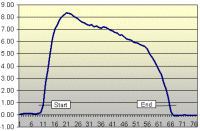
|
Model
rocket motor, "C" Class, paper tube, clay nozzle. Experiment
with fuse paper as possible ignition facilitator. Historically,
these small, low-Kn motors require BP priming or catalyzed propellant
to avoid severe chuffing. This plain-rcandy grain was wrapped with
one layer of rich fuse paper, no catalyst, no priming. Ignited with
fuse. Ignition is swift, no chuffing at all. Propellant weight:
6.6g, Total thrust: 6.25 Ns, Burn time:
0.23 second, ISP: 97 Propellant is fast-burning for the plain kind, 8 seconds per linear inch at 1 atm. Burn-through header of plain propellant continued for about 6 seconds after thrust began. |
Video 0.7 meg |
||||||||||||||||||
| 4-5-05A2 |
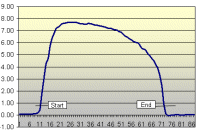
|
Model Rocket Motor: Another test
of the fuse-paper primer. Again, good ignition, no chuffing. Propellant
same as before, 8 seconds per linear inch at 1 atm. Propellant weight: 7.0g, Total thrust: 7.14 Ns, Burn time: 0.25 second, ISP: 104 Burn-through header of plain propellant went out when propellant was exhausted, did not finish its burn. |
Video 0.7 meg |
||||||||||||||||||
| 4-6-05A1 |
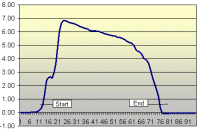
|
Model Rocket Motor: Third test of
fuse paper primer. This one is using slower-burning propellant,
21 seconds per inch at 1 atm. Such slow propellant is much harder
to ignite than the fast stuff, so this is a stricter test of the paper
primer. But it still ignited immediately, burned quickly and cleanly,
no chuffing. Propellant weight: 6.5g, Total thrust: 5.81 Ns, Burn time: 0.26 second, ISP: 91 Burn-through header, same propellant with 1% RIO burned for 6 seconds after first thrust. |
Video 0.7 meg |
||||||||||||||||||
| 4-6-05A2 |
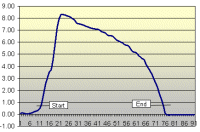
|
Model Rocket Motor: Fourth test of fuse
paper primer. Still slow-burning propellant. Again, quick
ignition and smooth burn. Propellant weight: 7.2g, Total thrust: 6.71 Ns, Burn time: 0.26 second, ISP: 95 No video - I had the camera set to take a still shot by mistake. Wanna see what it looked like? Just check out any of the last three tests. It looked pretty much the same. Burn-through header continued for roughly six seconds after first thrust. |
No Video
|
||||||||||||||||||
| 4-7-05A |
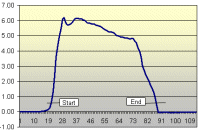
|
Model Rocket Motor: Fifth test of
fuse paper primer. Same slow-burning propellant as last two, but
3.6% fine Ti sponge added. This time, fuse inserted only to the bottom-end
of the propellant grain to see if fuse paper would carry ignition to full
grain quickly. It did. Quick ignition, fast rise, nice sparkle! Propellant weight: 6.2g, Total thrust: 5.86 Ns, Burn time: 0.28 second, ISP: 96 |
Video 0.7 meg |
||||||||||||||||||
| 4-9-05A |
See NEFAR 4-9-05 launch page |
Flight Test, 38-720 casing using two moon-burner
grains, one with delayed Ti. Flown in rebuilt Ariel, now painted
flourescent yellow and re-christened "Yellow Dog." |
|||||||||||||||||||
| 4-9-05B |
See NEFAR 4-9-05 launch page |
Flight Test, 38-720 casing using two moon-burner
grains, one with delayed Ti. Flown in rebuilt Ariel, now painted
flourescent yellow. |
|||||||||||||||||||
| 4-10-05B |
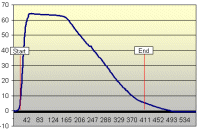
|
Static test of the motor design flown twice
yesterday at the NEFAR launch. This is the Dr. Rocket 38-720 casing
with two moon-burner grains, their cores carefully aligned. The
forward grain has a delayed Ti element which fires 0.6 seconds into the
1.8 second burn. Fuse paper ignitor Propellant weight: 247g, Total thrust: 295 Ns, Burn time: 1.8 second, ISP: 122 |
Video 1.2 megs |
||||||||||||||||||
| 4-11-05A |
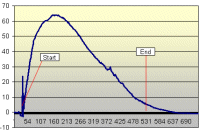
|
54mm Loki casing with 0.25 inch nozzle throat.
Burning a short moonburner grain 5.25 inches long, delayed Ti. Fuse
paper ignitor Propellant weight: 300g, Total thrust: 343 Ns, Burn time: 1.99 seconds, ISP: 116 Ti delay: 0.63 seconds Contrary to appearance, the horse isn't really freaked out, she just likes to play. |
Video 3 megs |
||||||||||||||||||
| 5-8-05C |
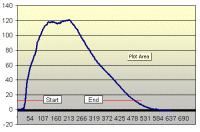
|
54mm Loki casing, single moonburner grain with
2.8 percent fine Ti. Grain is 8.5 inches long, nozzle drilled to
5/16ths throat diameter. Novel smoke grain design, attempting to
get long smoke from short grain. It didn't work - there was no significant
smoke after propellant burn. Motor worked fine, though: Propellant weight: 497g, Total thrust: 640 Ns, Burn time: 1.89 seconds, ISP: 131 (ISP is a bit optimistic, since the "smoke grain" burned along with propellant grain, it should be added to the propellant weight. When this is added, ISP drops to 119.) |
Video 1.5 megs |
||||||||||||||||||
| 8-7-05A |
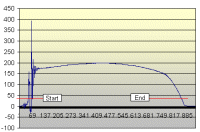
|
"Big
Sugar" motor, casing made by Richard Creamer and Steve Ghioto, burning
two large KN/SU grains made by Jimmy. Grains are 3.5 inches diameter
by 5 inches long. Tall peak at beginning is test stand artifact. This
is the bathroom scale test stand, which had been damaged in the Big Sugar
CATO of July. Not much of a CATO, it just popped off the nozzle, but
that was enought to distort the innards of this scale, and I did not realize
it until after this test. Things were bent. Propellant weight:
2310g, Total thrust: 2567N, Burn time: 3.28 seconds,
ISP: 113.38 Good burn. Richard is building an airframe for this motor, which we hope to fly in October. |
Video 1.3 megs .wmv file |
||||||||||||||||||
| 8-21-05A |
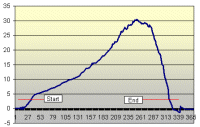
|
38-240 casing, single inhibited grain, expected
to be progressive, and it is. Includes 5% Ti mill chips from Eric Franzen, facilitated by Seth Leigh (Thanks!). Propellant weight: 86g (not including weight of Ti), Total thrust: 87Ns, Burn time: 1.19 seconds, ISP: 104 Large Ti chips made for a dramatic display, may have caused some irregularities in thrust curve, but these do not seem to be a killer problem, would probably be less so with larger motors having larger nozzle throats. |
Video 1.9 megs, 13 seconds .wmv file |
||||||||||||||||||
| 9-4-05C |
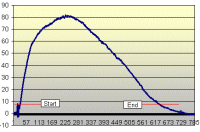
|
54mm Loki casing with single moonburner grain. This
grain was made back in June and sealed in the case liner with foil tape.
The tape didn't hold, the grain was real gooey on the outside. Two
grains like this fired on 8/13/05,
worked OK...maybe. 45g of goo removed from this grain and reprocessed
into good propellant for another day. Propellant weight: 451g (not including Ti or smoke grain) Total thrust: 596Ns, Burn time: 2.49 seconds, ISP: 135 (probably not... I think the smoke grain burned as propellant, inflating the score. |
Video 1 meg, 7 seconds .wmv file |
||||||||||||||||||
| 9-5-05B |
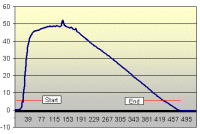
|
38-720 Dr. Rocket casing burning 2 moonburner grains
of plain rcandy. Grains aligned with aluminum-foil duct tape, which
served as their packaging. Grains were made on 5/6/05, and thus have
endured 4 months of Florida swelter. Upon opening the package, the propellant
was found to be completely dry. The "tidy
package" works! Some loose Ti mill flakes placed at head end, pointy
point on curve coincides with their exit. Propellant weight: 238.7g, Total thrust: 249 Ns, Burn time: 1.7 seconds, ISP: 106 |
Video 1 meg, 7 seconds .wmv file |
||||||||||||||||||
| 9-10-05A |
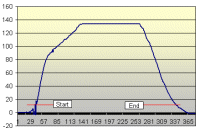
|
Loki 54mm 3-grain casing with new .435 inch nozzle,
firing 3 grains rcandy with 2.7% coarse Ti chips. Fired in Test Stand
B, 500lbf load cell, with Amp C, gain set with 47 ohm resistor. This
is too much gain, data is truncated above 133 lbf. Thus thrust and
ISP values are low. Propellant weight: 543g, Total thrust: 580 Ns, Burn time: 1.25 seconds, ISP: 109 Falling Ti started several small fires around the test area. It had not rained in a couple of days, and the dry grass was....well, it was dry. I am now aware that this propellant has a high potential as an incendiary agent. I'll use the delayed Ti technique for any launch motors. |
Video 1 meg, 5 seconds, .wmv file |